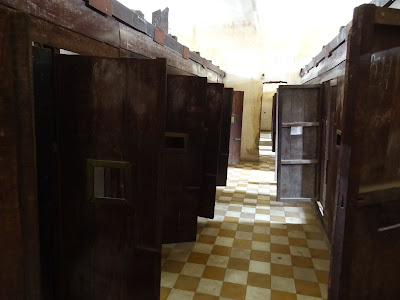Thursday, 8 August 2013
Phnom Penh; Cambodia; Asia; Khmer Rouge; Cheung Ek; S21; Tuol Sleung Museum
The sombre side of Cambodia's capital: Phnom Penh
Like most capital cities in Asia Phnom Penh holds a certain appeal. Fast paced, high living inter-wound with the traditions of the local culture and faith is abundant and the contrast is particularly apparent as local markets and temples sit alongside western bars and restaurants on the riverside.
While this is all well and good, it is the recent history and monuments that play testimony to it that drew us to Phnom Penh.
As I've already mentioned Cambodia suffered extensively at the hands of Pol Pot and the Khmer Rouge and it is the atrocities committed though their rule that are exposed in many ways here. We spent the day visiting the Killing Fields and Tuol Sleung Museum and as we learnt and saw more of what had happened we encountered a myriad of emotions including shock, sadness, anger and awe.
In the Tuol Sleng Museum there are photos of people celebrating as the Khmer Rouge tanks rolled into Phnom Penh. Their coming marked the end of the civil war, which had been raging in the country since the former Head of State was deposed by the military five years earlier. But in fact it was only the beginning of something far worse. Within days the city had been evacuated, families torn apart and all had been sent to work back-breaking 12-hour days on farms in the countryside. Anyone seen as being an intellectual was rounded up and killed. This included anyone who spoke a foreign language, wore glasses or had soft hands! Schools, universities and hospitals were shut down, currency was abolished and it was declared to be "Year 0".
Prior to 1975 Tuol Sleng was a high school but it was later taken over by Pol Pot's security forces and turned into a prison known as Security Prison 21 (S21). It became the largest centre of detention and torture in the country, with around 20,000 held here during the regime. Only seven people survived when liberation forces came three years later. It still feels very much like a school and you can imagine children playing here, which makes it quite chilling. Large poles in the playground which had been used for physical education, were later turned into a torture machine.
The "subversives" were brought here and held in tiny cells for 2-4 months, during which time they were subject to interrogation and horrific torture... to the extent that even young boys admitted that they had belonged to both the CIA and the KGB. The museum displayed a photograph of every prisoner as they were admitted, and many of them after they'd been tortured to death. There were also photos of the Khmer rouge prison-guards - many of whom were just young peasant boys.
Eventually those who didn't die from torture or starvation were transported to the extermination camp at Cheung Ek (the "Killing Fields"). Here in the dark of night, while the generators whirred, huge glaring lights were switched on and national music blared out to hide the sounds of people being murdered. Bullets were too expensive so people were beaten and hacked to death into mass graves. Women and children - some no more than babies - were amongst the victims.
The Killing Fields moved us most of all. It is a peaceful place, with green fields, orchards, a lake, and the sound of trees gently rusting in the breeze - entirely at odds with the horrors that occurred here.
There are 129 mass graves here, containing the remains of almost 9000 people. Not all of the graves have been exhumed and even today, fragments of bone and clothing rise to the surface after heavy rain. People have hung friendship bracelets all around the mass graves and on a tree against which babies were beaten to death as a sign of respect and humanity which is a touching sight.
There is also the Memorial Stupa, which is filled with skulls and other bones which were uncovered here.
Together S21 and the Killing Fields give a stark picture of the genocide that went on in this country only 30 years ago and what its people had to endure. It put our time with the children at the AHCO into more context and only strengthened our resolve to help. How the country has pulled itself together so quickly is testimony to its people, some of the warmest and friendliest we have ever met.
Subscribe to:
Post Comments (Atom)











0 comments:
Post a Comment